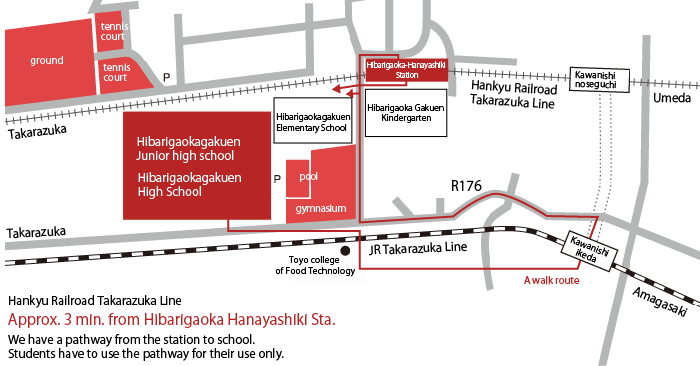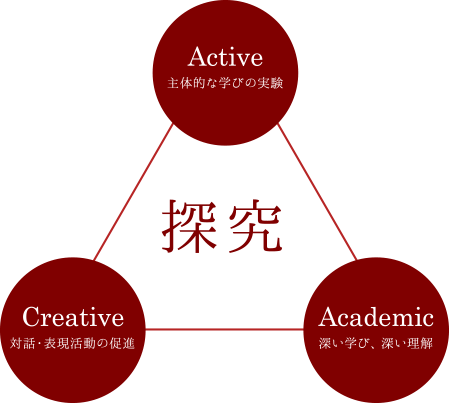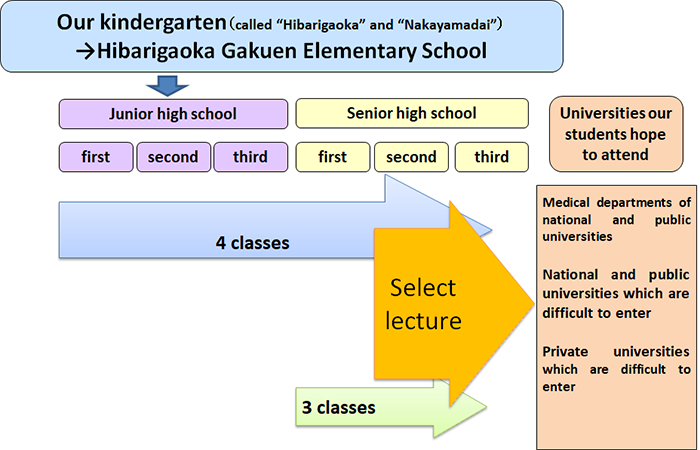
Hibarigaoka Gakuen Junior & Senior High School English Page
The greeting of the chief director
In Showa 25, we were in turmoil after the war. We did not have any schools in this area. Inhabitants in this area wanted their children go to school, and then our school, Hibarigaoka Gakuen, was established. This region called Hibarigaoka has been a residential area with beautiful scenery, so this is also an ideal environment in which to educate children. Shinjiro Torii, the first chief director, expounded that those students who respected their parents were able to be respectable, which is fundamental to our education. Now it has been 69 years since our school was founded, and this way of thinking is still the basis for each student to enhance their personality and ability. We, Hibarigaoka Gakuen, continue to try to educate our students to play an important role in the world.
TORII, Shingo
The greeting of the principal
We hope for you to make yourselves independent. At Hibarigaoka Gakuen, we have been making our students rich through "koudou," which means filial piety, and taught the students as "Jiritsugata-Ningen" with the spirit of "Yatteminahare," which means trying to do what you want. Jiritsugata-Ningen means those people who have courage and ability to take action. We lead our students to learn about various kinds of values, and experience intercultural exchanges in order to create this kind of student. Also, we always try not to merely give lots of knowledge, but stimulate their intellectual curiosity. We stress the importance of thinking for ourselves and trying to do things ourselves. Let us try various things to be Jiritsugata-Ningen with good friends and teachers.
NAKAI, Hiroyuki
The Spirit of the Establishment
We think of "koudou" as the most significant. We have a regard for the spirit to devote ourselves to society. In order to make our society and nation better, we have to be submissive and have gratitude to all things surrounding us. We hope to create great people who have enough physical strength and ability to take action.
Access
From the direction of Osaka (Umeda) Take an express or local train bound for Takarazuka or Hibarigaoka Hanayashiki at Umeda Station (Hankyu Railway) and get off at Hibarigaoka Hanayashiki Station. (approx. 25 min.)
From the direction of Takarazuka
Take an express or local train bound for Umeda at Takarazuka Station (Hankyu Railway) and get off at Hibarigaoka Hanayashiki Station. (approx. 10 min.)
Approximately 5 minutes' walk will take you to our school from Hibarigaoka Hanayashiki Station.

School Motto

- "Koudou"(孝道)
This means that you should be filial, and you can do whatever you want to do and have to do. - "Yatteminahare"(やってみなはれ)
This means that you should try everything that you want to do. It is not until you try to do it that you can realize how important and valuable it is.
Educational Vision
By focusing on developing academic achievement and our strength as humans, we make our students independent. At Hibarigaoka Gakuen Junior and Senior High School, our students have been educated for six years, based on the instruction from careful plans. By doing this, our students can develop their own academic achievement and cultivate a rich humanity. Based on the spirit of "Yatteminahare," we develop our students' abilities to be global leaders, who try new things, have clear opinions, and are resourceful.

Course Guidance

Curriculum
| Junior high school | 1st and 2nd grade | Japanese Language (Reading & Grammar) Geography & History Mathematics (Algebra & Geometry) Chemistry, Physics & Biology Music Fine Arts Technical Arts & Home Economics Physical Education & Health Education English (Reading, Grammar & Interaction and Production) Ethics Special Activities The Period for Integrated Studies |
| 3rd grade | Japanese Language (Reading & Grammar)
Integrated Social Studies & Civics Mathematics (Algebra & Geometry) Chemistry, Physics & Biology Music Fine Arts Technical Arts & Home Economics Physical Education & Health Education English (Reading, Grammar & Interaction and Production) Ethics Special Activities The Period for Integrated Studies |
|
| Senior high school | 1st grade | Integrated Japanese Language World History A Contemporary Social Studies Mathematics I & A Basic Chemistry, Physics & Biology Physical Education & Health Education Music Fine Arts Calligraphy English (Reading, Writing & Interaction and Production) Living, Information&Communication Special Activities The Period for Integrated Studies |
| 2nd grade | Contemporary Japanese B & Classical Japanese B World History B, Japanese History B (for the Humanities Course) Geography A Politics & Economics (for the Humanities Course) Mathematics Ⅱ & B Chemistry, Physics & Biology (for the Science Course) Physical Education & Health Education English (Reading, Writing & Interaction and Production) Home Economics Special Activities The Period for Integrated Studies |
|
| 3rd grade | Contemporary Japanese B & Classical Japanese B Japanese Language Exercises (for the humanities Course) World History B, Japanese History B (for the Humanities Course) Geography Exercises Moral Philosophy, Politics & Economics Mathematics Ⅲ (for the Science Course) Mathematics Exercises Chemistry, Physics & Biology (for the Science Course) Science exercises (for the Humanities Course) Physical Education English (Reading, Writing & Interaction and Production) English Exercises (for the Humanities Course) Special Activities The Period for Integrated Studies |
School Terms
- 1st term : April - July
- 2nd term : September - December
- 3rd term : January - March
Lessons
One lesson is 50 minutes long. Between lessons, we have a 10-minute break. We have 6 lessons a day Monday through Friday and 4 lessons on Saturday. Each grade has several additional lessons in a week.
Term Exams
The 1st and 2nd terms have 2 exams each, and the 3rd term has 1 exam.
Students' Score
| Evaluation | Integrated Score
|
|---|---|
| 5 | 75~100 |
| 4 | 55~75 |
| 3 | 35~54 |
| 2 | 30~34 |
| 1 | Less than 29 |
Students' one-week Schedule
| Junior High School 3rd Grade | ||||||
|---|---|---|---|---|---|---|
| Mon. | Tue. | Wed. | Thu. | Fri. | Sat. | |
| 8:30~8:45 Morning Assembly | ||||||
| 1 8:45~ 9:35 |
English 1 | Physical Education | Science 2 | Music | Science 2 | Technical Arts & Home Economics |
| 2 9:45~10:35 |
Integrated Social Studies | Civics | Geometry | Science 1 | English Interaction and Production | Algebra |
| 3 10:45~11:35 |
Science 1 | Algebra | English 1 | Civics | English 2 | English 1 |
| 4 11:45~12:35 |
Japanese Language (Grammar) | Japanese Language (Reading) | English Interaction and Production | Fine Art | Algebra | Japanese Language (Reading) |
| 12:35~13:20 Lunch Time | ||||||
| 5 13:20~14:10 |
Physical Education | Calligraphy | Integrated Social Studies | Algebra | Science Experiments | |
| 6 14:20~15:10 |
Geometry | English 2 | HR | Physical Education | Japanese Language (Grammar) | |
| 7 15:20~ 16:10 |
Moral Learning | Japanese Language (Reading) | ||||
Club Activities
| 【Athletic】 | 【Culture】 |
|---|---|
| Baseball | Fine Arts |
| Basketball | English Speaking Society |
| Football | Tea Ceremony |
| Judo | Flower Arrangement |
| Kendo | Drama |
| Soft tennis | Science |
| Swimming | Railroad |
| Tennis | Koto Music |
| Track & Field | Volunteer Activities |
| Volleyball | Calligraphy |
| Chorus | |
| Igo and Shogi | |
| Guitar and Mandolin | |
| Brass Band | |
| Broadcasting | |
| Photography |
Programs
We have several programs you can join. These programs are so beneficial to you. When you take part in them, you can grow up to be more attractive.
| Global Communication | |
|---|---|
| Training to be global | English Zone |
| Language Study Tour to Canada (for junior high school students) | Language Study Tour to New Zealand (for high school students) |
| Science | |
| Hibari Science Partnership Program (for junior high school students) | Suntory Scientist Experience (for high school students) |
| Academic Summer (for high school students) | |
School Facilities
Students can use school facilities.
| School infirmary | When they are sick or injured, students can use this room and take a rest. Around the school, there are several hospitals, so in an emergency, they can be sent to a hospital very soon. |
| School library | Our school library has about 32,000 books. Students can probably find what they want to read. This opens during each ten-minute break and after school. |
| Dining hall | At lunch time, students can buy a lunch ticket and have lunch with their friends. |
| Auditorium | Several events, such as ceremonies and contests, are held in the auditorium. This can accommodate about 900 people. |
